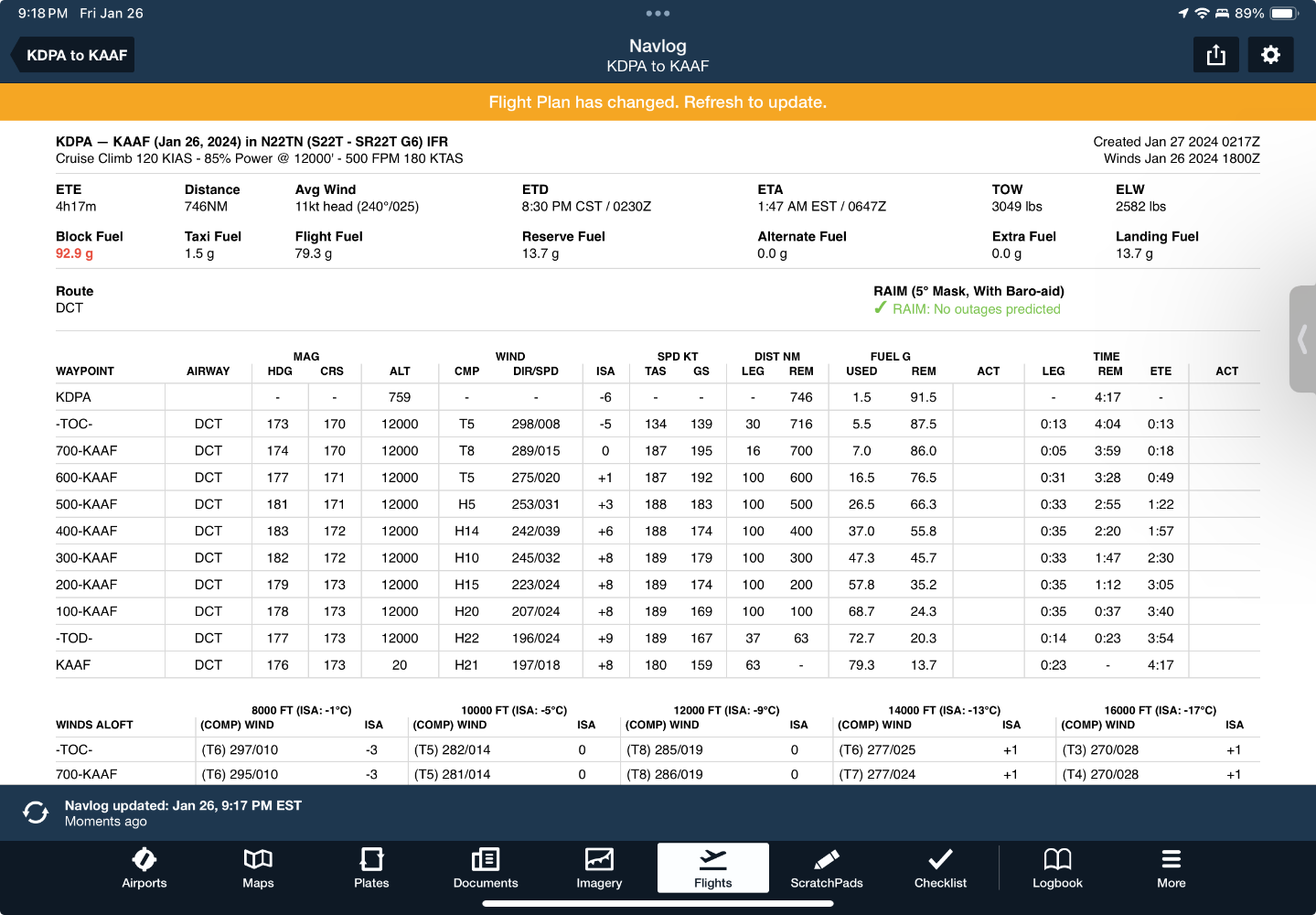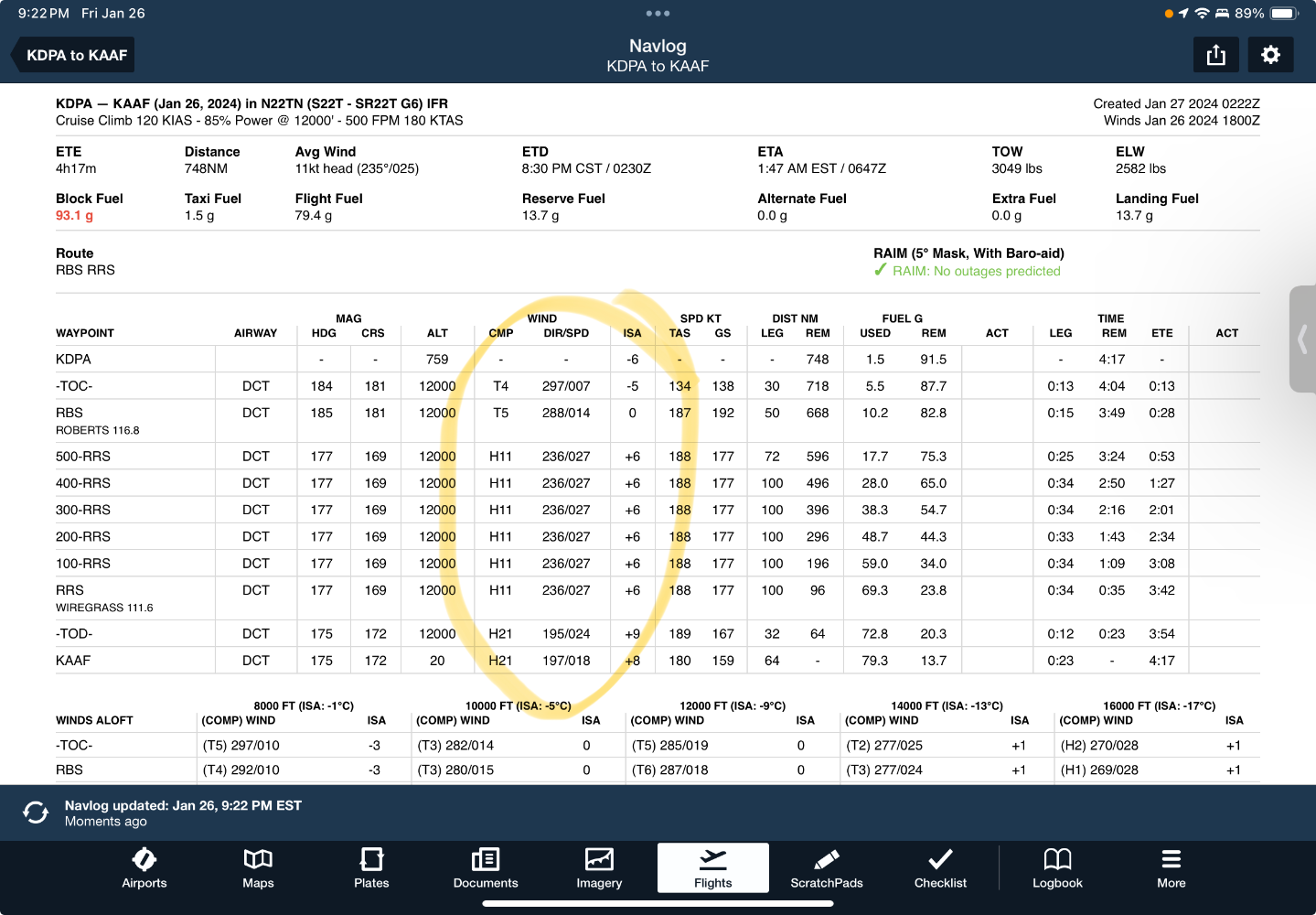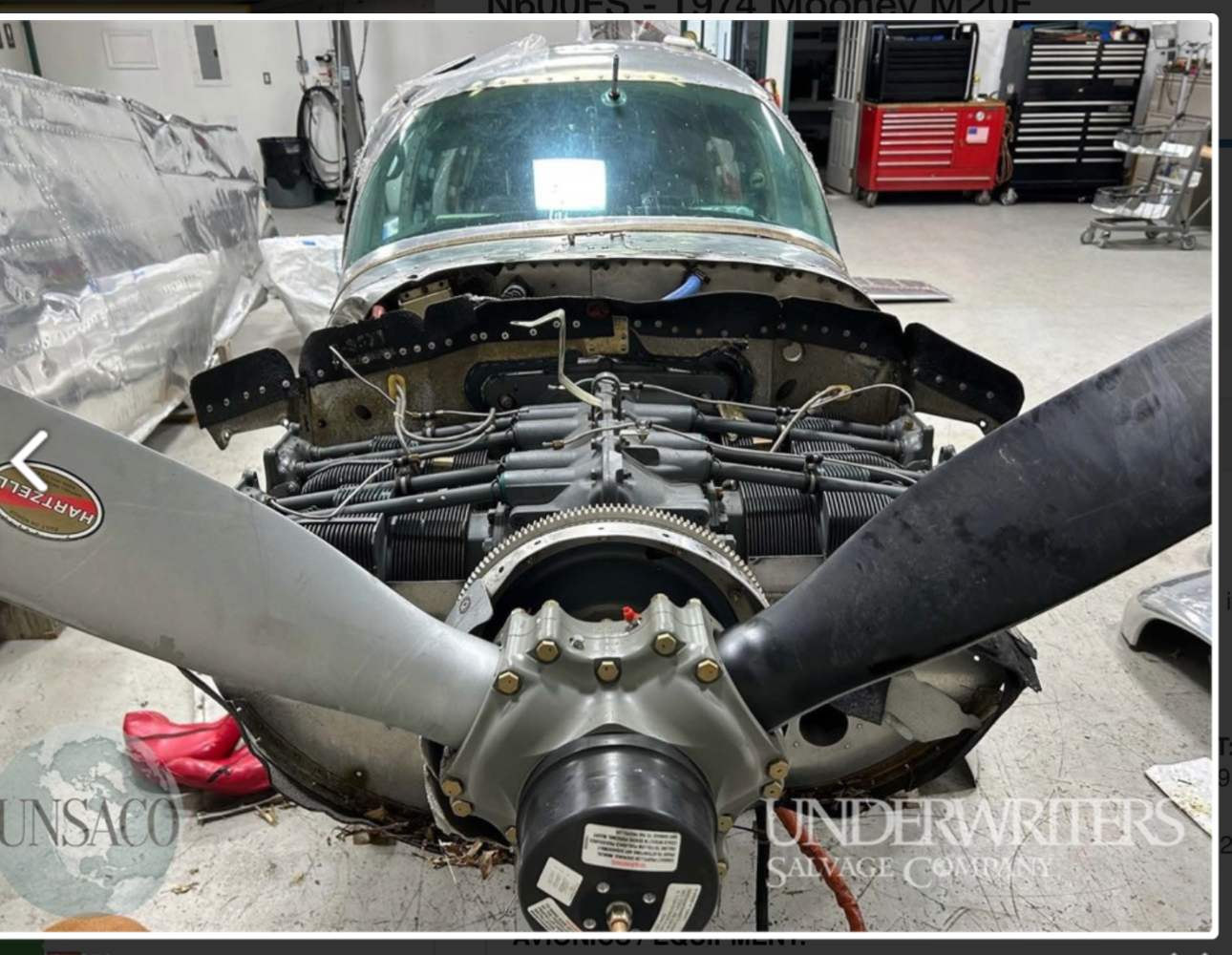-
Posts
1,613 -
Joined
-
Last visited
-
Days Won
2
Content Type
Profiles
Forums
Blogs
Gallery
Downloads
Events
Store
Everything posted by exM20K
-
No yes, says the guy who really knows lol. thanks @CAV Ice -dan
-
If the fluid is warm, this is not uncommon. Premier in FXE used to keep some in a fridge to test systems. -dan
-
Could be. My factory system had basically no service loop (slack) going from the proportioning valves to the wing panels. Did the system come up to operating pressure? -dan
-
Try here https://themooneyflyer.com/cfi.html I have known Michael Baraz for a long time and would recommend him without hesitation if he has sufficient M20R time. If he is unable, @mike_elliott should be able to send someone your way. https://www.mooneypros.com -dan
-
Run the system for 10 minutes or so, and as @Fritz1noted above, try wetting the panels from the outside. Are you getting fluid out of all the panels? The low pressure sensor is in the vertical tail, pretty high above the pump. It is very sensitive. it may be worthwhile anyway to get rid of the old fluid if it’s been in there for a while. Try to capture some and check the pH against spec. Old fluid can get acidic, which isn’t great for your metal plane. -dan
-
This is what Don Maxwell told me to do, and it works shockingly well for me. Just put stuff where it was before you shut dow. @mike_elliott’s method also works, but I have to text him to send me the recipe when I infrequently need it. -dan
-

Tight Landings, Take Offs, and Close Calls!
exM20K replied to Tim-37419's topic in General Mooney Talk
You may need to slow down more than that. In my incident, BOS Approach left me stupid high for rwy 5 at KBED. I used to always try to fly a 1.3x Vso max final, just to keep things consistent. Still do. So I was trimmed for that speed, alone in the cockpit (forward CG) and forward slipping. I wanted to make E taxiway as I parked at Atlantic, and full length taxi takes forever. The yoke is where I felt the buffet, kind of pulsing in and out. I relaxed the slip, and the plane flew normally, landed long, and did the long taxi back. I’d be very careful taking it beyond the onset of buffet or light elevator. -dan -

Tight Landings, Take Offs, and Close Calls!
exM20K replied to Tim-37419's topic in General Mooney Talk
Acclaim (and likely ovation/bravo) are not so. Especially with 310HP STC, landing distance is the limiting factor for me. https://www.aopa.org/go-fly/aircraft-and-ownership/aircraft-guide/aircraft/mooney-acclaim -dan -

Tight Landings, Take Offs, and Close Calls!
exM20K replied to Tim-37419's topic in General Mooney Talk
the six cylinder turbo planes are working the tail much harder, hence the small extension on the K and TN elevator trailing edge. I might know someone mentioned in this clip…. Link not working correctly, so here's the text From the Mooney List December 2, 2005 by Bob Kromer Slipping a Mooney During development and certification on the M20K 252 at the factory, I encountered the aerodynamic buffeting while slipping on approach as described by Dan Eldridge in his posting on slips in his M20K 231. Obviously, this gets a test pilot's attention and we began an investigation. Thought you might be interested in what we found. For our slip tests, we flew the M20K, the M20J and the Mooney/Porsche engineering prototypes that were at the factory at the time. This gave us a good cross section of different aircraft configurations (short/long fuselage, different pitch trim requirements on approach, etc.) What we found was 1) All airplanes were fine above 85 KIAS in full rudder deflection forward slips, flaps up and flaps down. 2) But somewhere between 80-85 KIAS and lower, AERODYNAMIC BUFFETING FROM THE HORIZONTAL TAIL/ELEVATOR occurred in the M20K and the Mooney/Porsche airframes ALONG WITH A SLIGHT LOSS OF ELEVATOR EFFECTIVENESS AND A SLIGHT NOSE DOWN PITCHING MOMENT. These conditions were worsened with flaps down compared to the flaps up. Aerodynamic tufting of the horizontal tail revealed what was happening. In the M20K and the Mooney/Porsche with their more forward CGs, almost full nose up pitch trim is required for a "hands off" approach at the target approach airspeed. This puts the horizontal stabilizer of the Mooney tail at a high negative angle of attack (to keep the nose up). With the horizontal tail at this high negative angle of attack and especially with flaps full down, the local airflow over the horizontal tail is getting pretty close to max alpha, the angle of attack where the tail will stall. I want to emphasize that IN NORMAL FLYING, THERE IS PLENTY OF MARGIN - no need to worry about the tail stalling in your M20K or long body Mooney. But start slipping the airplane at 85 KIAS and below or have a little ice on that stabilizer leading edge and those margins can get mighty thin. Combine a slip maneuver with some pretty good yanking on the control wheel in turbulence and you might get a partial tail stall. We did in flight test - in the M20K the result was buffeting felt in the control wheel and the slight nose down pitching moment. So my advice from the test pilot's seat is don't go there - especially if you fly a Mooney model that requires lots of nose up pitch trim on the approach. An aggressive forward slip in those airplanes with the speed low and the flaps down puts the tail in an extreme airflow condition. The airplane will warn you with buffeting and a slight pitch down, but who knows - add some ice and look out. This is not the way to fly your Mooney. My bottom line opinion - keep the ball near center on the approach and you're flying the Mooney design correctly and safely with the safety margins it was meant to have. Best Regards; Bob Kromer -dan -
Also, I don’t fly a cirrus but use it in this example to reassure myself how much more awesome the Acclaim is in every way.
- 1 reply
-
- 3
-

-

-
This is just sad. I’ve been a big ForeFlight fanboy since day one. Tyson was a solid guy who did some great work for us before ForeFlight got yuge. But it seems Boeing has the reverse Midas touch: everything they touch turns to poop. Boeing bought ForeFlight in March of 2019, just before their 737 max planes started lawn darting. I sincerely hope all the original ForeFlight equity holders didn’t get destroyed with an AMT liability. That can be life changing. Anyway, I reported an issue with winds aloft as reported in a FF nav log issue. Origin to destination nav log looks good. Example: KDPA to KAAF direct Notice the winds aloft are interpolated every 100 miles. That’s great, because you can monitor your time/fuel along the way and have some idea if the forecasts are busted and a fuel stop is likely. now, let’s add two waypoints, which is how I file and what is cleared. KDPA RBS RRS KAAF. that’s a long way between those two fixes, and look what happens to the winds aloft calculations: they are now averaged for the between-the-fix leg, which makes it simply impossible to determine en-route if the winds aloft forecast is good. There has been an “engineering ticket” open since October. This is a big deal for me, and the company appears to give zero poops about it. Perhaps the FAA would. -dan
-
You could have two on your plane: https://www.diamondaircraft.com/en/private-owners/aircraft/da62/overview/ Regrettably, that would come with an unacceptable reduction in cruise performance. Plus they're kinda spendy, and you can't get a new one till 2025. -dan
-
No it doesn't. the updater app warns about it but does say some systems are everything on one card. -dan
-
Mine's different: everything is on the bottom cards, and flight data gets written to top MFD slot. I tried putting nav data on a separate card and got all sorts of errors. My understanding from others is that the bottom cards don't write to the G1000's memory but rather are read by the unit, making them vulnerable to card failure, but in 7 years and ~1000 hours of flying it, I haven't had an issue. Maybe I'll have it sorted out in a few months at it's annual. -dan
-
The bottom card reader on my PFD is FUBAR'd - it won't release the card w/o pliers, and that wrecked the original card. I now have a replacement card in its place, which is fine. However, I'll have the same issue when the next update rolls along. I don't see any option to crossfill or synch from the MFD, which I think is possible in many installations. Garmin said it's a manufacturer-specific setting. So my question: Is there anyone out there with an ovation or acclaim that has the crossfill / synch working on a G1000? If so, could you tell me your software version and if there was any setup switch to throw? Thanks in advance -dan
-
The loads may be the same direction, but the force is very different. But I’m not suggesting I know it is unwise, as you are asserting it is not. I’m simply saying stopping a Mooney with the prop is untested and not the thrust vector the mounts were engineered to carry. For me, there are enough unknowns, dubious utility, and significant additional expense that I wouldn’t do it. That was @PMcClure ‘s question when he resurrected this zombie thread. -dan
-
decelerating a 3000# airplane from 75 ->0 in 1000 feet is an entirely different load than pushing on the prop or going to idle in flight.
-
The motor mounts are designed for the engine to pull the plane. How does pushing with the reversed prop affect the mounts? Nobody knows…. -dan
-
If you need reverse thrust to get stopped, you'll never get out of that field again. -dan
-
I run LOP ATT, so the belly gets the off-white powdery exhaust residue. I’m a big fan of the aero cosmetic products and use them on the plane and our motor home. However, the red solution will not cut this exhaust residue as it is not oil. This product does get it off with medium effort. This is a local company, and they are good guys. They also sell on Amazon, IIRC. -dan
-
I use these https://www.sportys.com/dupont-sontara-window-wipes-pack-of-25.html
-
Yes. Lemon Pledge is a much less expensive solution, too. -dan
-
Nice job by the pilot saving his or herself.….”fly as far into the crash as you can.” It looks like he or she put a great deal of time and money into that plane (panel, new engine, polished aluminum). It must be devastating to see it destroyed. would an E model run at all with the cowl plugs in? I doubt my plane would. It is a good habit to drape the tether for cowl plugs in front of one prop blade so that it will be snatched loose when the engine is cranked. At least one of the prop blades appears to be spun 180*, which is odd but likely an artifact of the crash and recovery. -dan
-
The guys that used to ferry DA42’s across the North Atlantic for us did have Depends on inside their Gumby survival suits. The legs on that route aren’t especially long, and they told me that they rarely had to “let it go.” But when they did, overcoming 20+ years of conditioning not to pee in one’s pants was really, really difficult to do. often, just having an outlet, so to speak, is sufficient to reduce the anxiety of having a #1 emergency. The PC12 is much more successful as a for-hire aircraft than is the TBM for a lot of reasons, but one that is a show-stopper for many is no potty in the TBM (except the Lego/Transformers contraption that is a never-ordered option on the TBM. Yet I’m told by operators that the PC12 potty is seldom used. Just knowing it’s there is enough. Absorbent undies are probably the same, if one can socialize their use with S/HWMBO. This entire post is based on hearsay :-) -dan
-
I'm currently at 20-25* spread, and it used to be less. I'm not super worried about it, and if you have one outlier rather than a front 2 vs back 2 CHT spread, try switching around a probe and lead from hottest to coldest. Like all probes, these do deteriorate over time. the oscillation in #3 I have used to be shown on #1 until we moved the probe and lead.





